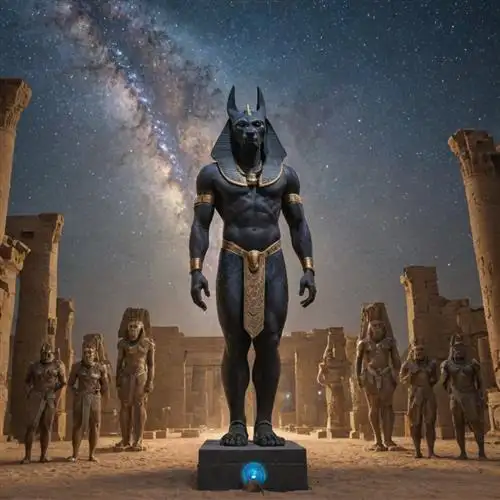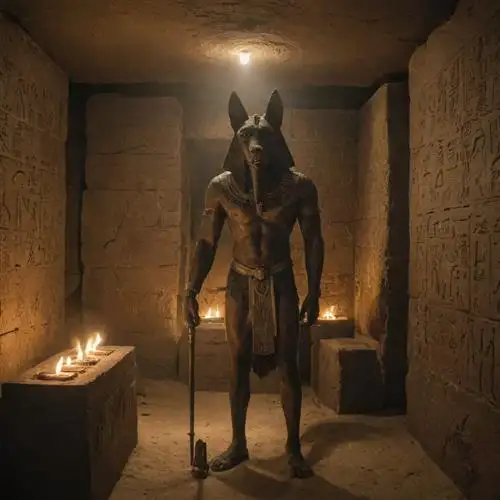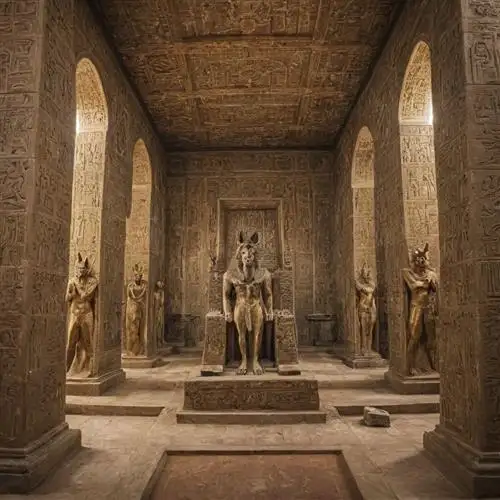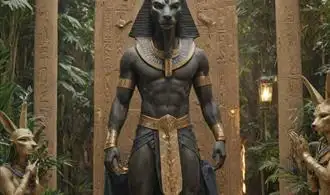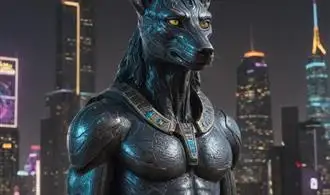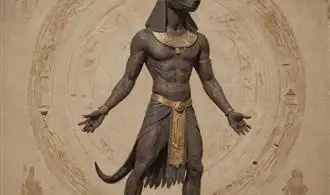
The Origins of Anubis
Anubis Role in Egyptian Mythology
Anubis, the jackal-headed deity, holds a pivotal role in the rich tapestry of Egyptian mythology. As the god associated with mummification, the afterlife, and the protection of the dead, Anubis' significance cannot be overstated. His influence permeates various aspects of ancient Egyptian culture, from funerary rites to the very conception of the afterlife.
At the heart of Anubis' role lies his responsibility for the embalming process and the transition of the deceased into the afterlife. As the god who presided over the mummification of the dead, Anubis was tasked with ensuring the proper preservation of the body, a crucial step in the journey to the afterworld. His presence during this ritual was believed to provide divine guidance and protection, ensuring the smooth passage of the soul into the realm of the dead.
Beyond his role in mummification, Anubis was also revered as the guardian of the deceased, responsible for the safekeeping of the dead and their possessions in the afterlife. This responsibility extended to the weighing of the heart ceremony, a pivotal moment in the ancient Egyptian conception of the afterlife, where the deceased's heart was weighed against the feather of truth. Anubis, as the overseer of this process, determined the fate of the soul, ensuring that the deceased had lived a righteous life and were worthy of eternal peace in the afterlife.
Interestingly, Anubis' association with the afterlife and the underworld also linked him to the concept of rebirth and regeneration. As the guardian of the dead, Anubis was seen as a figure of transition, guiding the deceased from the mortal realm into the realm of the eternal. This symbolism of rebirth and transformation further cemented Anubis' importance in the ancient Egyptian pantheon, as the faithful believed in his ability to facilitate the journey to the afterlife and the ultimate attainment of eternal life.
The Iconography and Symbolism of Anubis
The iconography and symbolism associated with the ancient Egyptian god Anubis are rich, complex, and deeply meaningful. As the jackal-headed deity responsible for the embalming process and the protection of the dead, Anubis' visual representation carries a wealth of significance that has captivated scholars and enthusiasts alike.
Anubis' distinctive jackal head is perhaps the most recognizable aspect of his iconography, symbolizing his role as the guide and protector of the deceased. The jackal, a common sight in the Egyptian desert, was believed to have a keen sense of smell and the ability to navigate the afterlife. By adopting this animal's head, Anubis was imbued with the qualities necessary to lead the dead through the perilous journey to the afterlife.
The color of Anubis' skin is also highly symbolic, often depicted in shades of black or dark gray. This coloration is thought to represent the decomposition of the body, as well as the color of the fertile Nile mud, which was believed to be the source of rebirth and regeneration. Fearless Exploration of the Iconography Surrounding Anubis delves deeper into the significance of Anubis' distinctive appearance.
Another crucial element of Anubis' iconography is the object he is often depicted holding or standing upon. The natron tray, used in the embalming process, is a common item associated with Anubis, symbolizing his role as the overseer of mummification. Additionally, Anubis is sometimes shown standing on a pedestal or dais, further emphasizing his position as a powerful and revered deity.
The posture and gestures of Anubis are also laden with meaning. In some representations, he is shown kneeling or crouching, a posture that suggests a protective or guarding role. In other instances, he is depicted standing upright, his arms outstretched or holding specific objects, conveying a sense of authority and guardianship over the deceased.
The symbols and iconography associated with Anubis are not limited to his physical appearance and posture. The jackal, as his animal representative, is often seen in Anubis-related artwork and imagery, reinforcing his connection to the natural world and the cycle of life and death. Additionally, Anubis is sometimes shown with other deities, such as Isis or Osiris, further emphasizing his role in the broader pantheon of Egyptian mythology.
Anubis Relationship with Other Egyptian Deities
Anubis, the jackal-headed deity, was a central figure in the intricate pantheon of ancient Egyptian gods. His relationship with other deities was multifaceted and intricate, reflecting the complex web of beliefs and rituals that permeated Egyptian civilization. As the god of the dead, Anubis played a vital role in the afterlife, and his interactions with other gods shed light on the interconnectedness of the Egyptian divine realm.
One of Anubis's closest associations was with Osiris, the god of the underworld and the dead. Anubis was responsible for embalming and preparing the deceased for their journey to the afterlife, ensuring a smooth transition for the soul. This close collaboration between the two deities was essential, as Osiris presided over the judgment and final resting place of the dead, while Anubis oversaw the physical preparation of the body.
Anubis's relationship with Isis, the goddess of magic and healing, was also significant. Isis was often depicted accompanying Anubis during the embalming process, using her powers to protect and aid the deceased. This partnership between the two deities underscores the importance of both physical and spiritual elements in the Egyptian conception of the afterlife.
In addition to his role in the funerary rites, Anubis was also closely associated with Thoth, the god of wisdom and writing. Thoth was responsible for recording the results of the weighing of the heart ceremony, a crucial step in the judgment of the dead. Anubis, as the guide and protector of the deceased, played a vital role in this process, ensuring the safe passage of the soul to the afterlife.
Anubis's relationship with Ra, the sun god, was also noteworthy. As the sun set each day, Anubis was believed to accompany the dead on their journey through the underworld, guiding them towards the realm of Osiris. This connection between Anubis and the sun cycle underscores the deity's role as a mediator between the living and the dead, and the cyclical nature of life and death in ancient Egyptian mythology.
The Funerary Rites and Rituals Associated with Anubis
Anubis, the jackal-headed deity of ancient Egypt, held a pivotal role in the funerary rites and rituals that guided the deceased through the afterlife. As the god responsible for embalming and protecting the dead, Anubis's involvement in the complex process of mummification was paramount. The ancient Egyptians believed that proper preparation of the body was crucial for the soul's successful journey to the afterlife, and Anubis was the divine overseer who ensured this intricate ritual was carried out with the utmost care and precision.
The process of mummification, overseen by Anubis, was a meticulous and symbolic endeavor. The body would be carefully cleansed, organs removed and preserved, and the skin and muscles treated with natron, a type of salt, to dry and preserve the remains. This transformation from physical body to "mummy" was believed to be a critical step in preserving the individual's essence, allowing the soul to maintain its connection to the physical form.
Beyond the mummification process, Anubis also played a vital role in the funerary rites and rituals that accompanied the deceased's journey to the afterlife. The The Secrets of Anubis Iconography Revealed delves deeper into the symbolism and significance of Anubis's iconography, which was often depicted in funerary art and artifacts. The jackal-headed god was present during the weighing of the heart ceremony, where the deceased's heart was weighed against the feather of truth, determining their worthiness to enter the afterlife.
Anubis also oversaw the actual burial process, guiding the deceased's body to its final resting place within the tomb or necropolis. The placement of the body, the choice of funerary goods, and the arrangement of the tomb itself were all influenced by Anubis's role as the god of the dead. The ancient Egyptians believed that Anubis's presence and protection ensured the smooth transition of the soul from the physical world to the next.
Furthermore, Anubis was invoked in various funerary rituals and ceremonies that continued long after the initial burial. Offerings, prayers, and invocations to Anubis were made to ensure the deceased's continued well-being and to seek the god's guidance and protection in the afterlife. The ancient Egyptians believed that Anubis's influence and oversight were essential in maintaining the delicate balance between the living and the dead.
The Cult and Worship of Anubis in Ancient Egypt
Anubis, the jackal-headed god, was a central figure in the religious and funerary practices of ancient Egypt. His cult was widespread throughout the land, with temples and shrines dedicated to his worship found in numerous locations. The significance of Anubis in the Egyptian pantheon cannot be overstated, as he played a crucial role in the afterlife journey of the deceased.
One of the most prominent aspects of the Anubis cult was his association with mummification and the embalming process. Anubis was believed to be the patron deity of embalmers and was responsible for guiding the deceased through the complex rituals of mummification. In this capacity, Anubis was often depicted as a jackal or a man with a jackal head, standing over the mummy and overseeing the embalming procedures.
The role of Anubis in the afterlife was equally significant. He was believed to be the gatekeeper of the underworld, responsible for weighing the hearts of the deceased against the feather of Ma'at, the goddess of truth and justice. This critical judgment determined the fate of the soul, with those found worthy passing into the afterlife and those deemed unworthy facing the devouring of their heart by the monster Ammit.
Anubis was also associated with the protection of the dead. Statues and amulets depicting the jackal-headed god were often placed in tombs and on the bodies of the deceased, believed to offer divine protection and guidance during the perilous journey to the afterlife.
The cult of Anubis was centered in several key locations throughout ancient Egypt, with the most prominent being the city of Cynopolis (modern-day Kom el-Chatl) in the Nile Delta region. Here, Anubis was worshipped as the primary deity, and the city was known for its extensive necropolis and mummification workshops.
In addition to his central role in funerary practices, Anubis was also revered as a god of healing and the protector of the living. Temples and shrines dedicated to Anubis were often sought out by those seeking his divine intervention for ailments or protection from harm.
The Legacy and Enduring Influence of Anubis
Anubis, the ancient Egyptian god of the dead, holds a profound and lasting influence that transcends the boundaries of time and culture. As the guardian of funerary rites and the keeper of the afterlife, Anubis's symbolism and significance have been woven into the fabric of human civilization for millennia. From its origins in the Nile Valley to its reverberations in modern popular culture, the legacy of Anubis continues to fascinate and captivate scholars, artists, and the general public alike.
At the heart of Anubis's enduring legacy is his role as the psychopomp, or the guide of souls to the afterlife. In ancient Egyptian belief, Anubis was responsible for the embalming process, ensuring the proper preparation of the deceased for their journey to the realm of the dead. This pivotal function cemented Anubis's status as a deity of immense importance, as the ancient Egyptians placed great emphasis on the preservation of the physical body and the successful transition of the soul to the afterlife.
The iconic image of Anubis, with his jackal-like head and canine features, has become a recognizable symbol of ancient Egyptian mythology and funerary practices. This distinctive appearance has contributed to Anubis's widespread recognition and has inspired numerous artistic representations, from ancient tomb paintings to modern-day tattoos and digital art. The visual power of Anubis has played a crucial role in the preservation and dissemination of his legacy, ensuring that the god's influence remains palpable in the contemporary world.
Beyond its visual impact, the mythology and symbolism surrounding Anubis have also had a lasting influence on various aspects of human culture. The Things You Didn't Know About Anubis and the Afterlife explores the intricate and often enigmatic connections between Anubis and the afterlife, shedding light on the god's role in the ancient Egyptian conception of the journey of the soul. This deep-rooted association with the afterlife has given rise to a wealth of artistic, literary, and philosophical exploration, reinforcing Anubis's status as a figure of enduring fascination and reverence.
The legacy of Anubis extends beyond the confines of ancient Egypt, with the god's influence permeating various modern-day cultural expressions. From the inclusion of Anubis in contemporary fantasy and science fiction narratives to the incorporation of his imagery in video games, music, and fashion, the god's enduring appeal is a testament to the timeless nature of his symbolism and the universal human preoccupation with death and the afterlife.




